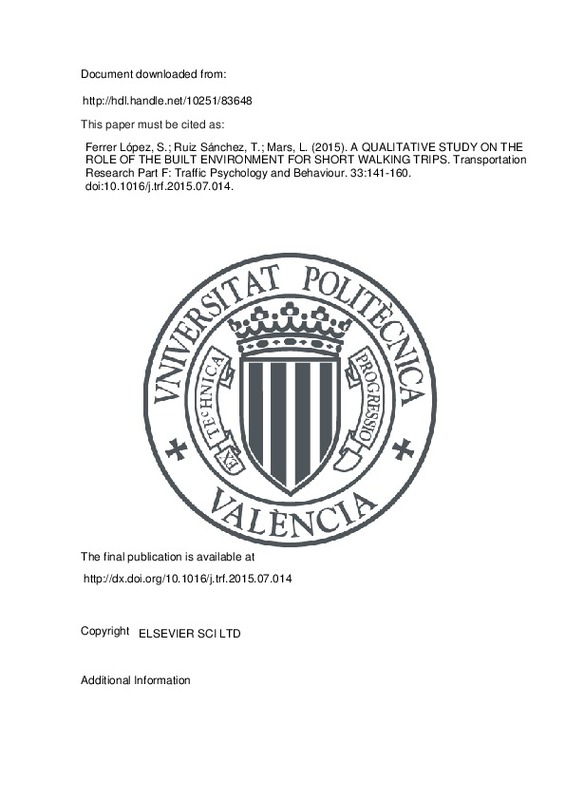JavaScript is disabled for your browser. Some features of this site may not work without it.
Buscar en RiuNet
Listar
Mi cuenta
Estadísticas
Ayuda RiuNet
Admin. UPV
A QUALITATIVE STUDY ON THE ROLE OF THE BUILT ENVIRONMENT FOR SHORT WALKING TRIPS
Mostrar el registro sencillo del ítem
Ficheros en el ítem
| dc.contributor.author | Ferrer López, Sheila
|
es_ES |
| dc.contributor.author | Ruiz Sánchez, Tomás
|
es_ES |
| dc.contributor.author | Mars, L.
|
es_ES |
| dc.date.accessioned | 2017-06-26T12:14:36Z | |
| dc.date.available | 2017-06-26T12:14:36Z | |
| dc.date.issued | 2015-08 | |
| dc.identifier.issn | 1369-8478 | |
| dc.identifier.uri | http://hdl.handle.net/10251/83648 | |
| dc.description.abstract | The present study uses a qualitative approach with the aim to identify built environmental factors influencing short walking distances for transportation among adults (18-65 years), with special attention to micro-scale attributes. Three focus groups were held in Valencia (Spain) and conducted with participants who undertook, at least once a week, one short non-shopping trip in any travel mode (were "short trip" is defined as less than 3045 min walking distance). A thematic analysis of the data was performed and six categories of factors emerged related to the built environment. Factors were also classified as either barriers to walking, or secondary factors related to the attractiveness of the walking experience and the pedestrian route choice. Results show that factors related to safety from crime are the most deterrent to walking (absence of people and poor street lighting), along with the availability of car parking at destination for car users. Crossing large avenues and roundabouts in Valencia can be a deterrent to walking because of the high density of pedestrian traffic signals with a poor coordination, leading to long crossing waiting times. Secondary factors such as wide sidewalks, the presence of trees, and low traffic volume roads were mentioned by almost all participants. Our findings suggest that sidewalk width may not only influence pedestrian route choice but can be a barrier to walking. Focus groups also revealed that sidewalk cafes and bollards were seen as physical obstacles by some participants. (C) 2015 Elsevier Ltd. All rights reserved. | es_ES |
| dc.description.sponsorship | We would like to thank the Spanish Ministry of Science and Innovation for funding the research project PEATON-TRA2011-27415. Furthermore, we would also like to thank the participants in the study and Pablo Garcia-Garces for his assistance with the focus groups. | en_EN |
| dc.language | Inglés | es_ES |
| dc.publisher | ELSEVIER SCI LTD | es_ES |
| dc.relation.ispartof | Transportation Research Part F: Traffic Psychology and Behaviour | es_ES |
| dc.rights | Reserva de todos los derechos | es_ES |
| dc.subject | Built environment | es_ES |
| dc.subject | Focus group | es_ES |
| dc.subject | Walking | es_ES |
| dc.subject | Pedestrian | es_ES |
| dc.subject | Short trip | es_ES |
| dc.subject | Mode choice | es_ES |
| dc.subject.classification | INGENIERIA E INFRAESTRUCTURA DE LOS TRANSPORTES | es_ES |
| dc.title | A QUALITATIVE STUDY ON THE ROLE OF THE BUILT ENVIRONMENT FOR SHORT WALKING TRIPS | es_ES |
| dc.type | Artículo | es_ES |
| dc.identifier.doi | 10.1016/j.trf.2015.07.014 | |
| dc.relation.projectID | info:eu-repo/grantAgreement/MICINN//TRA2011-27415/ES/METODOLOGIAS DE ENCUESTA DE TRANSPORTE PEATONAL Y ANALISIS DE LA MOVILIDAD A PIE/ | es_ES |
| dc.rights.accessRights | Abierto | es_ES |
| dc.contributor.affiliation | Universitat Politècnica de València. Departamento de Ingeniería e Infraestructura de los Transportes - Departament d'Enginyeria i Infraestructura dels Transports | es_ES |
| dc.contributor.affiliation | Universitat Politècnica de València. Escuela Técnica Superior de Ingenieros de Caminos, Canales y Puertos - Escola Tècnica Superior d'Enginyers de Camins, Canals i Ports | es_ES |
| dc.description.bibliographicCitation | Ferrer López, S.; Ruiz Sánchez, T.; Mars, L. (2015). A QUALITATIVE STUDY ON THE ROLE OF THE BUILT ENVIRONMENT FOR SHORT WALKING TRIPS. Transportation Research Part F: Traffic Psychology and Behaviour. 33:141-160. https://doi.org/10.1016/j.trf.2015.07.014 | es_ES |
| dc.description.accrualMethod | S | es_ES |
| dc.relation.publisherversion | http://dx.doi.org/10.1016/j.trf.2015.07.014 | es_ES |
| dc.description.upvformatpinicio | 141 | es_ES |
| dc.description.upvformatpfin | 160 | es_ES |
| dc.type.version | info:eu-repo/semantics/publishedVersion | es_ES |
| dc.description.volume | 33 | es_ES |
| dc.relation.senia | 298446 | es_ES |
| dc.contributor.funder | Ministerio de Ciencia e Innovación | es_ES |







![[Cerrado]](/themes/UPV/images/candado.png)

